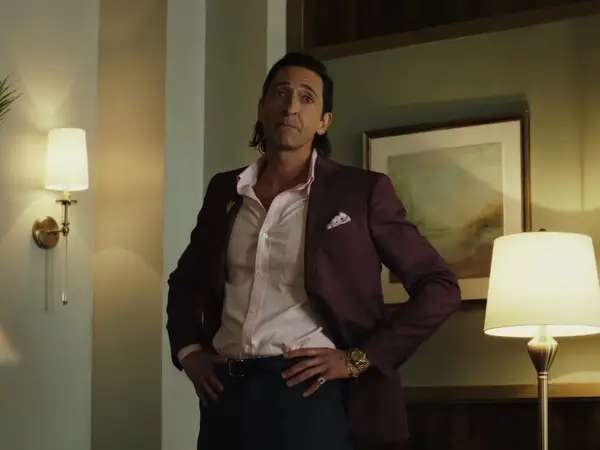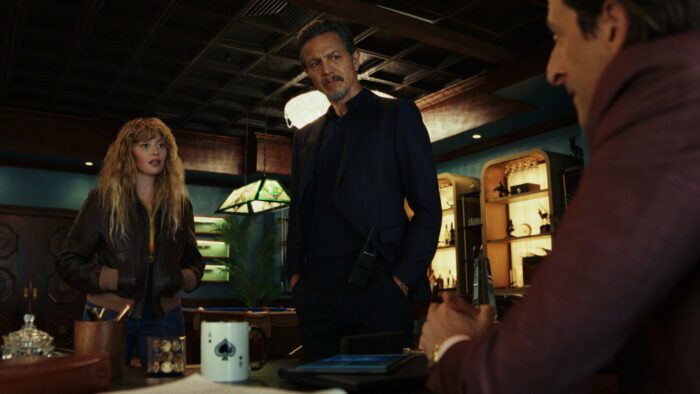The following contains spoilers for the Poker Face premiere, S1E1, “Dead Man’s Hand” (written and directed by Rian Johnson) and S1E2, “The Night Shift” (written by Alice Ju, and directed by Rian Johnson)
How appealing you will find the new Peacock original series Poker Face comes down to how you feel about this sentence: Rian Johnson and Natasha Lyonne create their version of Columbo. But putting the spoilers at the top, as one must, if that sentence does appeal to you then this show is nearly perfect.
Johnson and Lyonne are both gifted creators and storytellers with current successful ongoing franchises. Lyonne’s Netflix series, Russian Doll, has been one of the best show’s on TV for each of its seasons, and Johnson’s Knives Out movies are basically creating their own genre. (Also his Star Wars movie was the best one, please direct your angry messages to the filing bin in the corner.) But they have joined together for Poker Face to bring their considerable talents to what feels like an entirely different style show in today’s era.
Johnson’s visual style is on display from the start with a vivid color palate and unconventional choices for shots that make the Poker Face premiere feel as cinematic as any film. The murder-mystery elements are tailor-made for the types of tricks that Johnson loves (the occasional wide pan and quick zoom can really sell how much of a terrible creep Adrien Brody can be in any medium). This comes together with a tight and easy-to-follow script and a very basic, but really enjoyable story.

There are two ways that Poker Face emulates Columbo, the first is in the way the mysteries are presented. In both shows you know who the murderer is, and how they did it, from the very first scene. This allows the show to clearly present the victim and the murderer and to actually do the important work that shows and movies based simply on the mystery can’t do. Because the mystery is secondary, the creators can make us care about the characters and their motivations. The fun for the audience is not in trying to figure out the mystery of what happened, the fun is in watching the lead character figure it out.
Of course, this wouldn’t work without a compelling and dynamic lead character and Natasha Lyonne’s Charle Case is an instantly iconic one. Lyonne is always a compelling performer and she lbrings a distinctiveness to her characters that is partially based on her own persona and partially a result of her incredible creative sensibilities. Lyonne’s Cale is a fully inhabited character from her first scene, and it is instantly clear both how and why she will be the center of Poker Face.
Of course, this leads to the second way that Poker Face clearly invokes Columbo, and that is in the lead characters themselves. Charlie Cale and Lieutenant Columbo are both preternaturally gifted and brilliant, but present themselves in an unkept, stumbling through the motions, manner that takes their targets completely off guard. The actors—Peter Falk and Natasha Lyonne—also have mirroring qualities. Each has a distinctive voice and unconventional looks that cause them to stand out from their contemporaries. (Of course, they both also had and still have plenty of devoted and obsessed fans.) Cale and Columbo both work all of this to their advantage, and it also really serves to draw the audience to their side immediately.
The other distinctive feature of Poker Face is that while there is still an overall “season arc”, each episode is supposed to present an unconnected stand-alone mystery. This seems to hold true in that Charlie Cale is investigating individual, unconnected murders. But then you watch the Poker Face premiere and it seems to focus most of the energy on setting up the season-long arc. The murder is intricately connected to Charlie and the ending sets Charlie out on her adventures, but with connections and characters from the S1E1 still following her. Having heard so often that the series was almost entirely stand-alone episodes I was surprised at how essential this season-long arc was to the premise and how all of “Dead Man’s Hand” was devoted to it.

Poker Face S1E1, “Dead Man’s Hand” has the highest degree of difficulty of any episode in the series: it has to do all the exposition and set up the character and stakes of the series, while also introducing the unique style and feel of the show. Johnson’s script and direction really do a great job setting up all of this. From the very first shot, Poker Face has such a distinctive style that it is set apart from almost everything else.
The introductory scenes are centered around Natalie (Dasha Polanco) who works at a casino run by Adrien Brody (his character is named Sterling Frost Jr. but I can only ever think of him as Adrien Brody) with his enforcer Cliff (Benjamin Bratt). We get to spend an entire day with Natalie as she deals with discovering something terrible on the laptop of the casino’s “whale” and then reports it to Frost and Cliff. We get to watch Sterling make the call to have Natalie killed, and then see Cliff kill Natalie and her (terrible deadbeat) husband and make it look like a murder-suicide.
Then we meet Charlie Cale. Lyonne is perfect in these introductory scenes and the character is instantly recognizable and iconic. It turns out that we have flashed back and we get to see Charlie interact with Natalie before her death. These scenes continue to deepen the connection the viewer has to Natalie and to really show unexpected depth to Charlie. They have a great bond and strong friendship and it makes Natalie’s death even more devastating both for Charlie and for the audience.
On the day of Natalie’s death, Charlie is also intricately tied to Sterling. Charlie also works at the casino and Sterling realizes she is a card shark being punished by his father for taking his money. So Sterling enlists Charlie in a plot to steal a bunch of cash from the “whale”—the same one who will cause Natalie’s demise. It turns out that Charlie is not just good at cards or a strong detective, she also has a superpower: she can tell if someone is lying. This is how she ran afoul of Sterling Sr. and how Jr. wants to use her in his plot. Of course, most importantly, it sets her up to solve mysteries in Poker Face.

When Charlie finds out Natalie has been murdered she can’t leave it alone and winds up pushing and prodding until she solves the case. Sterling jumps. Ben shoots Charlie in the stomach and she escapes to live on the run. So by the end of the Poker Face premiere, the status quo for the first season is set. Charlie is on the run and goes from town to town solving mysteries while being pursued by Cliff and trying to make sure no one discovers who she is. (So the show also has a strong The Incredible Hulk vibe, and the whole Bill Bixby/Dr. David Banner connection works almost as well as the Peter Falk/Colombo one.)
This structure is great, and really necessary, as it allows so much more drama and stakes throughout the show to be based on what the audience knows being in opposition to what the characters know. We know that every time Frost winds up in a scene with Cale, he might give something away and we get to watch her as she figures out all the details. This format makes it much more satisfying both when Frost is found out and winds up jumping to his death and also in each scene where Cale is trying to find out information because it raises the tension for the audience through the drama, not the mystery.
It is with Poker Face S1E2, “The Night Shift” that the series really starts to sizzle. Johnson, Lyonne, and the creative team have brought in an incredible string of guest stars for the season, and 2023 Oscar nominee Hong Chau anchors the episode in what is likely the “real” series pilot. “Dead Man’s Hand” set up the premise, introduced us to Charlie and did the expositional heavy lifting while “The Night Shift” just lets the premise cook.
The structure is the same as in “Dead Man’s Hand” we get to spend some time with the victim Damian (Brandon Micheal Hall) and the murderer Jed (Colton Ryan). We get to see Damian’s affability and connection with Sara (Megan Suri) with whom both men are infatuated. Then we see Jed’s strangeness and jealousy lead him to murder Damian. Jed then winds up lucking into framing a trucker named Marge (Hong Chau) for the murder. Then, just like in the Poker Face premiere, we jump back in time to Charlie’s arrival in the town.
Charlie and Marge spend the day together, with Marge doctoring Charlie’s wound and basically allowing Chao and Lyonne to play off of each other’s amazing chemistry and comedic chops for a few scenes. Then Charlie discovers that Marge has been framed for the murder and, in classic TV detective fashion, she just can’t let it go. She literally takes a u-turn back into the tiny town to use her deduction and solve the murder.

“The Night Shift” is even better at engaging the audience in the premise because it no longer has to do the expository work; the viewer knows about Charlie’s power and they know that Jed is no match for her. That she will solve the mystery is no secret—Jed may be the single stupidest murderer ever put on screen—but the mystery is all about how she will figure it out. And in this case, the solution hinges on Sara, lottery tickets, bottle caps, and truckers as all mysteries really should.
The only ties back to the season-long arc are that Charlie winds up pinging her location causing Cliff to arrive looking for her. Charlie spends this time fearful, but in another delightful difference from so many shows, everyone she meets seems to genuinely like her. The town mechanic (John Ratzenberger in a rare return to TV) is actually honest and helpful and fixes his horrible nephew’s attempt to murder her. Sara realizes Cliff is bad news and sends him to California (and presumably out of the show for a few episodes). So in the end, Charlie saves the day and heads off to the next adventure. Though if people keep dying as soon as she arrives in these small towns then Season 2 will need to be about how the FBI is launching a manhunt for Charlie Cale, the serial killer.

